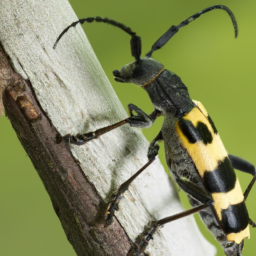Firma Web Siteniz Var mı?
Mükemmel Bir Firma Web Siteniz Olsun, Bugün Kullanmaya Başlayın
*256 Bit SSL Sertifikası * Full Mobil Uyumlu * Full SEO Uyumlu
İsterseniz Mobil Uygulama Seçeneğiyle

Adı : grape trunk borer
Bilimsel Adı : Clytoleptus albofasciatus (Laporte & Gory)
Clytoleptus albofasciatus (Laporte & Gory) is a type of beetle that is commonly known as the grape trunk borer. It is a significant pest that affects grape crops, and it is found in several areas worldwide, including Asia, Europe, and America.
Grape trunk borers are small beetles that belong to the family Cerambycidae. They are approximately 7 to 12 millimeters long and have a slim, cylindrical body shape. They are typically black, but they can have various colors or patterns on their wings and body. The grape trunk borer has a distinctive white band across its front wings, which helps identify it from other types of beetles.
The larvae of the grape trunk borer inflict most of the damage to grapevines. They bore into the wood of the grape trunk, which weakens the vine and can eventually kill it. The larvae feed on the wood for one to two years before they pupate and emerge as adult beetles. The adults also feed on the wood of the vine, but they do not cause as much damage as the larvae.
Grape trunk borers are more problematic in vineyards that have been established for many years. The older the vine, the thicker and more mature the wood, and the more vulnerable it is to attack by the grape trunk borer. The pest can infest a vine quickly, and it is challenging to control once it has established itself within a vineyard.
There are several methods to control grape trunk borers, including cultural practices, chemical treatments, and biological controls. Cultural practices involve maintaining healthy vines by pruning, watering, and fertilizing them adequately. This helps reduce stress on the vine and makes it less vulnerable to pests and diseases. Chemical treatments using insecticides can help control grape trunk borers, but care must be taken to avoid harming beneficial insects or contaminating the environment. Biological controls use natural predators or parasites that help reduce the grape trunk borer population.
In conclusion, the grape trunk borer (Clytoleptus albofasciatus) is a significant pest that affects grape crops worldwide. It is challenging to control once it has established itself within a vineyard, and several methods can be used to control it, including cultural practices, chemical treatments, and biological controls. Implementing integrated pest management practices can help reduce the overall impact of the grape trunk borer and protect grapevines in the long term.

Adı : grape trunk borer
Bilimsel Adı : Clytoleptus albofasciatus (Laporte & Gory)
Clytoleptus albofasciatus (Laporte & Gory) is a type of beetle that is commonly known as the grape trunk borer. It is a significant pest that affects grape crops, and it is found in several areas worldwide, including Asia, Europe, and America.
Grape trunk borers are small beetles that belong to the family Cerambycidae. They are approximately 7 to 12 millimeters long and have a slim, cylindrical body shape. They are typically black, but they can have various colors or patterns on their wings and body. The grape trunk borer has a distinctive white band across its front wings, which helps identify it from other types of beetles.
The larvae of the grape trunk borer inflict most of the damage to grapevines. They bore into the wood of the grape trunk, which weakens the vine and can eventually kill it. The larvae feed on the wood for one to two years before they pupate and emerge as adult beetles. The adults also feed on the wood of the vine, but they do not cause as much damage as the larvae.
Grape trunk borers are more problematic in vineyards that have been established for many years. The older the vine, the thicker and more mature the wood, and the more vulnerable it is to attack by the grape trunk borer. The pest can infest a vine quickly, and it is challenging to control once it has established itself within a vineyard.
There are several methods to control grape trunk borers, including cultural practices, chemical treatments, and biological controls. Cultural practices involve maintaining healthy vines by pruning, watering, and fertilizing them adequately. This helps reduce stress on the vine and makes it less vulnerable to pests and diseases. Chemical treatments using insecticides can help control grape trunk borers, but care must be taken to avoid harming beneficial insects or contaminating the environment. Biological controls use natural predators or parasites that help reduce the grape trunk borer population.
In conclusion, the grape trunk borer (Clytoleptus albofasciatus) is a significant pest that affects grape crops worldwide. It is challenging to control once it has established itself within a vineyard, and several methods can be used to control it, including cultural practices, chemical treatments, and biological controls. Implementing integrated pest management practices can help reduce the overall impact of the grape trunk borer and protect grapevines in the long term.
Maç Yorumları Web Sitesi
Yapay Zekanın Yaptığı Maç yorumlarını sitenizde otomatik yayınlayın!
*256 Bit SSL Sertifikası * Full Mobil Uyumlu * Full SEO Uyumlu
İsterseniz Mobil Uygulama Seçeneğiyle
üzüm kökü zararlısı Cerambycidae larva pupa yetişkin böcek kültürel uygulamalar kimyasal tedaviler biyolojik mücadele
